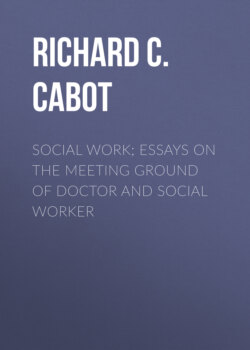Читать книгу Social Work; Essays on the Meeting Ground of Doctor and Social Worker - Richard C. Cabot - Страница 13
На сайте Литреса книга снята с продажи.
Nests of contagious disease
ОглавлениеTable of Contents
So far I have been describing the work of the social worker as a process of finding out how much ails the patient and what his symptoms signify. But it is also a part of the social worker's duty to find how much disease is present not only in the individual who appears in the clinic, but in his immediate environment, to discover nests, foci or hotbeds of disease. In the case of a disease like smallpox, this is obvious. If a patient presented himself at a dispensary with the pustules of smallpox upon his body, it would be criminal negligence on the part of the physician not to set on foot a search of that patient's home, his industrial environment, or, in the case of a child, his school environment, for evidence that others have been exposed to the same contagion and possibly already infected. This sort of duty cannot be abandoned merely because there is no health officer at hand. It is a crying need and must be attended to at once.
Now in a minor degree this is true of many other diseases as well as smallpox. We are beginning to realize that it is true of tuberculosis, so that when one case of advanced and therefore contagious tuberculosis is seen at the dispensary, machinery should automatically and invariably be set in motion to search out possible paths of contagion from that patient to others, just as if he had smallpox.
This principle which is well established in the case of dangerous contagious diseases like smallpox and diphtheria, and is beginning to be established in relation to tuberculosis, is even more important in dealing with syphilis. Every case of syphilis means more cases of syphilis, and the danger of still more each day that the contagious patient is at large. No physician has done his duty unless, after seeing a case of syphilis, he attempts, through a social worker or otherwise, to get knowledge of others from whom this disease has been acquired, or to whom it may be freshly spread. At the Massachusetts General Hospital each patient with syphilis is asked to bring to the clinic for treatment the person who infected him. The method sounds impossible but in fact it works, and many cases are thus brought under treatment and prevented from infecting others.
With contagious skin diseases such as scabies or impetigo, the principle is obviously the same, though the dangers of disregarding it are not so great. With typhoid fever, which not very infrequently shows itself even at a dispensary, the duty of the social worker is not so much to search for other persons through whom it may have been contracted or to whom it may be spread, as to investigate the water-supply and the milk-supply of the patient and of others in his environment. One case of typhoid always means more cases, usually more cases acquired, not by contact with one another, but through their share in a contaminated water-supply or milk-supply. The social worker, therefore, should know how to search out contaminated water-supplies, or at least to put in motion such machinery of public health investigation in the city or town where the case arises as may lead to good detective work in the attempt to track down the source of the trouble. It has been well said that every case of typhoid is some one's fault. It has even been asserted that for every case of typhoid some one should be punished. Certainly there are some grounds for such an assertion.
